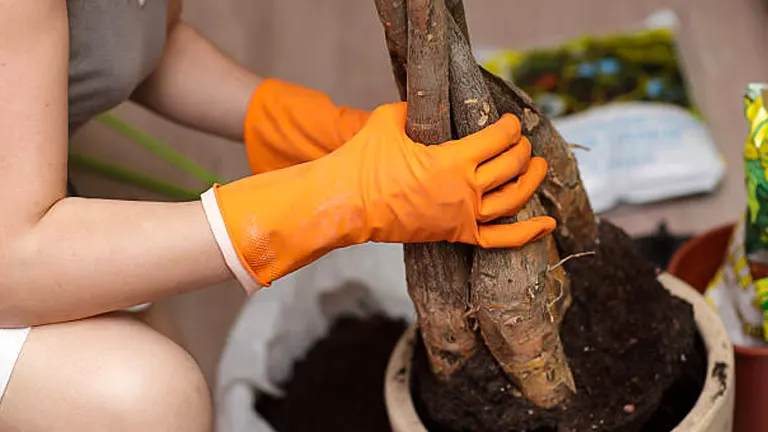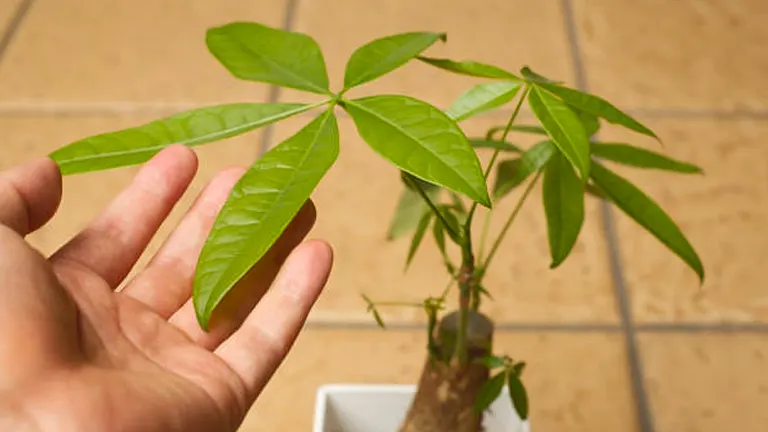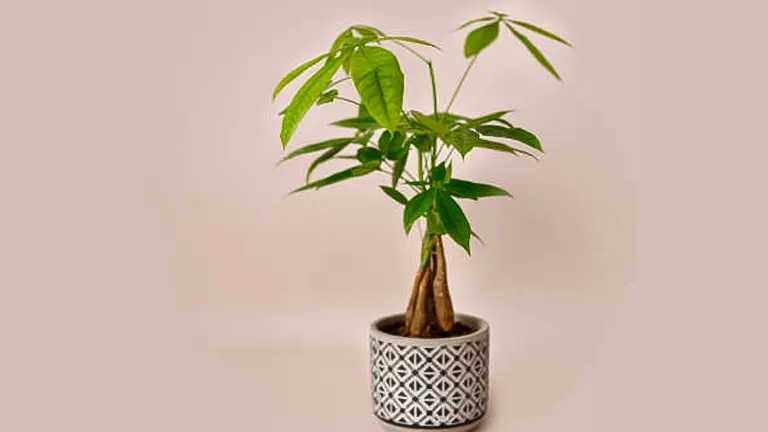How to Fertilize Money Trees: Boost Growth & Avoid Errors
- April 19, 2024
- 0 comment
Learn how to fertilize money trees to enhance growth and prevent common mistakes. Follow these simple, effective tips for lush, healthy plants. Caring for your money tree involves more than just watering it; you need the right fertilization strategy to ensure it thrives. In this guide, we’ll explore the best practices that not only promote robust growth but also help you steer clear of the common pitfalls that many plant owners face.

Whether you are a seasoned gardener or a new plant parent, these straightforward tips will help you grow a lush, vibrant money tree. Let’s dig into the essentials of proper fertilization and set your greenery on the path to flourishing health.
Table of Contents
- Understanding Your Money Tree’s Needs
- Caring for Potted Money Trees
- Choosing the Right Fertilizer
- Proper Fertilization Techniques
- Pruning Your Money Tree
- Navigating Common Fertilization Errors
- Monitoring and Adjusting Care
- Conclusion
- FAQs
Understanding Your Money Tree’s Needs
Soil Preferences

The foundation of a healthy money tree lies in its soil. The ideal soil composition is a symbiosis of well-draining capabilities and nutrient retention. A mix of peat moss, perlite, and coarse sand in equal parts is recommended, but let’s delve deeper into why this mix works and how it supports the intricate root system of a Pachira aquatica.
- Loamy Soil & Aeration: Loamy soil, characterized by its balanced mixture of sand, silt, and clay, provides an optimal structure for root growth and oxygen circulation. Perlite enhances this mix by improving aeration and drainage, essential qualities to avoid anaerobic soil conditions that harm root health.
- Organic Matter: Peat moss contributes to the mix by adding organic matter, which holds water and nutrients well. This organic matter slowly decomposes, releasing nutrients over time and providing a continuous feed to the roots. However, it’s important to note the sustainability concerns associated with peat moss and consider alternatives like coco coir for a more eco-friendly option.
- Soil pH and Nutrient Uptake: The ideal pH range for money trees is between 6.0 and 7.5. This slightly acidic to neutral pH maximizes the availability of essential nutrients such as nitrogen, phosphorus, and potassium. A pH outside this range can lock nutrients in the soil, making them inaccessible to the plant.
Enhanced Soil Mix Table
| Component | Volume Part | Purpose |
|---|---|---|
| Peat Moss (or Coco Coir) | 1 | Adds organic matter and retains moisture |
| Perlite | 1 | Improves aeration and drainage |
| Coarse Sand | 1 | Adds weight and further improves drainage |
Watering Requirements
Watering is a science in itself. The key is not to follow a rigid schedule but to understand the moisture needs of your plant, which can vary significantly with factors like pot size, indoor temperature, and the plant’s growth stage.
- Moisture Monitoring: Use a soil moisture meter for a more accurate assessment of when to water. These devices can provide a digital reading of moisture levels, allowing you to water with precision. Aim for a moisture level that corresponds to the top 2-3 inches of soil being dry.
- Seasonal Adjustments: Consider the relative growth rate during different seasons. A money tree’s growth slows in the winter, necessitating less frequent watering. Using a hygrometer to monitor humidity levels in your home can help you adjust your watering schedule in harmony with environmental humidity.
Environmental Factors
Creating an environment that mimics a money tree’s natural habitat promotes its health and growth.
- Humidity & Microclimate: To achieve the optimal humidity range of 50-60%, group plants together to create a microclimate, enhancing the local humidity through their collective transpiration. Alternatively, pebble trays filled with water placed beneath the plant pots can increase local humidity without the need for electrical humidifiers.
- Temperature Fluctuations: Money trees are comfortable in temperatures between 65°F (18°C) and 80°F (27°C). Use a digital thermometer to monitor room temperatures and avoid placing your plant near heating vents or air conditioners, as these can create hot or cold drafts that stress the plant.
- Lighting Needs: Quantify light using a lux meter, aiming for a spot that receives around 10,000 to 15,000 lux, which translates to bright, indirect light suitable for money trees. Direct sunlight, especially during the harsh noon hours, should be avoided as it can exceed 20,000 lux, leading to leaf burn.
Caring for Potted Money Trees

Properly caring for potted money trees involves more than just the right soil and water—it’s about the entire habitat, from pot selection to the specific location within your home.
Selecting the Right Pot
The choice of pot for your money tree is not merely a decorative decision; it significantly impacts the health of your plant. Pots made of breathable materials, like terracotta or ceramic, are ideal because they allow air and moisture to move through them, helping to prevent soil waterlogging and root rot. These pots also tend to dry out more evenly and quickly than plastic pots, which is beneficial for moisture regulation.
- Size Matters: The pot size should give your plant ample room to grow but not so much that the soil stays wet for too long. A good rule of thumb is to choose a pot that is about 2 inches larger in diameter than the previous one.
- Drainage Is Key: Ensure your pot has one or more drainage holes at the bottom. Good drainage is crucial for preventing excess water from sitting at the root level, which can cause root decay and fungal problems.
Repotting Basics
Money trees typically need to be repotted every 2-3 years to prevent them from becoming root-bound and to refresh the soil, which can become compacted and nutrient-depleted over time. Repotting also gives you a chance to inspect the roots for any signs of disease or decay, which can be addressed before they become serious.
- Best Time to Repot: Early spring, right before the growth season begins, is the ideal time for repotting as the plant will have time to establish itself in the new pot before going into a state of active growth.
- Step-by-Step Guide:
- Preparation: Water your money tree thoroughly a day before repotting to make the process less stressful for the plant.
- Removing the Plant: Gently take the plant out of its current pot, brush off the old soil, and inspect the roots. Trim any dead or overly long roots.
- Adding Soil: Place a layer of new, pre-moistened potting mix at the bottom of the new pot.
- Positioning the Plant: Set the plant in the center and add more potting mix around the sides, tapping down lightly to remove air pockets.
- Final Touches: Water the newly potted plant lightly to settle the soil and place it in a location that receives indirect sunlight.
Moving a money tree into a new home is not just a functional act but a renewal ritual that can invigorate your plant, giving it a fresh start and new nutrients to process.
Choosing the Right Fertilizer

Selecting the appropriate fertilizer is pivotal for the health and growth of your money tree (Pachira aquatica). Fertilizers not only supplement your plant with essential nutrients but also enhance soil health, supporting your plant’s overall ecosystem. Below, we delve deeper into the types of fertilizers, their compositions, and how to choose the best one for your money tree, including a detailed table for quick reference.
Types of Fertilizers
- Organic Fertilizers: These are derived from natural sources such as fish emulsion, seaweed, or composted manure. They not only supply essential nutrients but also improve soil structure and promote beneficial microbial activity.
- Inorganic Fertilizers: These synthetic options typically offer a precise NPK (nitrogen, phosphorus, potassium) ratio that can be tailored to the plant’s needs, providing a quick nutrient boost.
What to Look for in a Fertilizer
- NPK Ratio: For money trees, look for a fertilizer with a higher nitrogen content to promote foliage growth. An NPK ratio of 3-1-2 is ideal.
- Micronutrients: Elements like magnesium, calcium, and sulfur are also crucial for the robust health of your plant.
- Release Type: Slow-release fertilizers are excellent for providing a steady supply of nutrients over several months, reducing the risk of root burn and the need for frequent reapplication.
When applying fertilizer, it’s important to follow the manufacturer’s instructions to avoid over-fertilization, which can lead to nutrient burn and other health issues in plants.
Understanding Fertilizer Types
Fertilizers come in various forms, each with specific benefits and uses designed to meet different gardening needs. Here’s a more scientific look at organic and inorganic options:
- Organic Fertilizers: Derived from natural sources such as fish emulsion, seaweed, composted manure, and bone meal, these fertilizers release nutrients slowly as they break down in the soil. They improve soil structure, increase water retention, and promote beneficial microbial activity, which enhances root health and nutrient absorption.
- Inorganic Fertilizers: These are synthetic formulations typically designed to provide immediate nutrient release. They can be customized to deliver specific NPK ratios, which is essential for targeting the nutrient needs of your money tree.
Detailed Analysis of Fertilizer Components
- NPK Ratio: The NPK ratio indicates the levels of nitrogen (N), phosphorus (P), and potassium (K) available in a fertilizer. For money trees, a higher nitrogen content is crucial as it promotes lush foliar growth. An ideal NPK ratio for money trees would be 3-1-2.
- Micronutrients: These include elements like magnesium (Mg), calcium (Ca), and sulfur (S), which are vital for the plant’s development. Magnesium is essential for chlorophyll production, calcium strengthens cell walls, and sulfur aids in protein synthesis.
- Release Type:
- Slow-release fertilizers decompose and release nutrients gradually, helping to maintain a consistent nutrient supply without the risk of root burn.
- Liquid fertilizers offer more immediate results and can be controlled easily in terms of dosage, making them suitable for a targeted feeding regimen.
Fertilizer Application Tips
When applying fertilizer, precision is key. Over-fertilization can lead to nutrient burn, characterized by browned tips and weak, floppy growth. It’s crucial to follow the manufacturer’s instructions for dosage and frequency.
- Application Method: Incorporate granular fertilizer into the soil around the plant to ensure that the nutrients are accessible to the roots. For liquid fertilizers, dilute as recommended and apply to the soil, not the foliage, to prevent leaf burn.
- Frequency: Generally, fertilizing your money tree once per month during the growing season (spring and summer) and reducing to once every two months during the dormant season (fall and winter) aligns with its natural growth cycle.
Fertilizer Selection Table
To simplify the process, here’s a table that outlines the types of fertilizers, their characteristics, and their benefits:
| Fertilizer Type | NPK Ratio | Ideal for Money Trees | Nutrient Release | Benefits |
|---|---|---|---|---|
| Organic | Varied | Yes | Slow | Improves soil structure, enhances microbial health |
| Inorganic | Customizable | Yes | Fast to moderate | Tailored nutrient supply, immediate effectiveness |
| Liquid | Varied | Yes | Immediate | Easy application, quick response |
| Slow-release Granules | 3-1-2 | Yes | Gradual | Consistent supply, minimal burn risk |
Scientific Insight
For those interested in the scientific aspect of fertilization, understanding the ionic balance and pH adjustments is crucial. For example, nitrogen is often provided in ammonium (NH₄⁺) or nitrate (NO₃⁻) forms, which can affect soil pH and subsequently, nutrient availability. A slightly acidic soil pH (around 6.0-6.5) is optimal for money trees, as it maximizes nutrient solubility.
Proper Fertilization Techniques
Navigating the fertilization process effectively is key to enhancing your money tree’s health and vigor. This section provides a clear and detailed approach to applying fertilizer, helping you avoid common mistakes and achieve optimal growth.
Frequency of Fertilization
Understanding when to fertilize your money tree is crucial for its growth and health. The frequency of fertilization largely depends on the growth phase of the plant:
- Growth Phase (Spring and Summer): Fertilize every four to six weeks. During these months, your money tree is actively growing, and regular feedings can significantly benefit its lush foliage development.
- Dormant Phase (Fall and Winter): Reduce fertilization to once every two to three months as the plant’s growth slows down. Over-fertilizing during these months can harm the plant due to the reduced need for nutrients.
Step-by-Step Guide to Fertilizing Money Trees
- Soil Testing:
- Before applying fertilizer, test the soil to determine the existing nutrient levels. This can help you choose the right type of fertilizer and avoid over-fertilization.
- Preparing the Fertilizer:
- If using liquid fertilizer, dilute it according to the instructions on the label to prevent nutrient burn.
- For granular types, measure the correct amount as stated by the product guidelines to match the pot size of your money tree.
- Application:
- Apply granular fertilizer evenly around the base of the plant, avoiding direct contact with the stem and roots to prevent burns.
- For liquid fertilizers, pour the diluted mixture evenly over the soil, ensuring it doesn’t pool around the base. This method helps the roots absorb nutrients efficiently.
- Watering After Application:
- Water the plant lightly after applying granular fertilizer. This helps to integrate the nutrients into the soil and makes them accessible to the roots.
- Ensure the water reaches deep into the roots but does not leave the soil waterlogged.
Dos and Don’ts of Fertilization
- Do:
- Follow the specific instructions provided by the fertilizer manufacturer.
- Adjust the amount and frequency based on the plant’s response. If the leaves become scorched or the soil builds up salt, reduce the quantity of fertilizer and frequency of application.
- Don’t:
- Over-fertilize by exceeding the recommended amounts or frequency. This can lead to nutrient burn, where the roots are damaged, leading to browning leaves and a decline in health.
- Use outdated or improperly stored fertilizers as they can lose effectiveness and might not provide the necessary nutrients.
Following these detailed steps will help ensure that your money tree receives the right amount of support to grow healthy and strong without the risks that come with over or under-fertilization.
Pruning Your Money Tree

Pruning is a vital aspect of money tree care that not only helps to maintain its appearance but also promotes healthy growth. Strategic pruning enhances the plant’s structure, encourages new growth, and helps prevent diseases by improving air circulation around the foliage.
When to Prune
The best time to prune your money tree is during the spring, which is the start of its active growth period. This timing allows the plant to heal quickly and use the growing season to produce new, healthy foliage.
Essentials of Pruning
- Tools Needed: Use sharp, clean pruning shears. Sterilize them before use to prevent the spread of disease.
- Identifying Which Branches to Prune:
- Remove any dead or yellowing leaves to maintain plant health.
- Cut back overgrown branches to help shape the plant and enhance its aesthetic appeal.
- Prune any crossing or crowded branches to improve light penetration and air flow, which is crucial for the prevention of fungal infections.
Step-by-Step Guide to Pruning Money Trees
- Preparation:
- Choose a well-lit area to work in so you can easily see the structure of the plant and identify which branches need cutting.
- Lay down newspaper or a tarp to catch the fallen leaves and branches for easy cleanup.
- Pruning Process:
- Start at the top of the plant and work your way down. This approach allows you to see the impact of your pruning decisions as you go.
- Make cuts at a 45-degree angle about 1/4 inch above a leaf node or bud. This angle promotes water runoff and healthy regrowth.
- Focus on thinning out the top of the plant to ensure light and air can reach the inner branches.
- Aftercare:
- Immediately after pruning, apply a small amount of water-soluble fertilizer to support recovery and new growth.
- Water the plant thoroughly, but ensure not to overwater as the roots may be more exposed and sensitive after pruning.
Pruning Tips
- Avoid heavy pruning; never remove more than one-third of the plant’s total foliage at one time.
- Regularly clean up fallen debris around the plant to prevent pest and disease problems.
- Inspect your plant periodically after pruning for signs of stress or disease and address any issues promptly to maintain the health of your money tree.
Rejuvenating Your Plant
Pruning is not just about maintaining size and shape; it’s a rejuvenation process that encourages your money tree to produce fresh, vibrant foliage. It invigorates the plant, prompting it to focus its energy on new growth that is robust and healthy.
Navigating Common Fertilization Errors

Fertilizing a money tree, like any aspect of gardening, comes with its potential pitfalls. Awareness and prevention of these common errors can significantly increase the health and vitality of your plant.
Over-Fertilization
Many plant enthusiasts are tempted to over-fertilize in hopes of boosting their plant’s growth. However, excess nutrients can overwhelm your money tree, leading to scorched leaves and a buildup of harmful salts in the soil.
- Signs of Over-Fertilization:
- Browned leaf edges and tips.
- Wilting, even with adequate soil moisture.
- Crusted fertilizer residue on soil surface.
Correction Strategy:
- Leach the soil by slowly running water through the pot for several minutes. Ensure thorough drainage and repeat several times.
- Reduce fertilizer application significantly and monitor the plant’s response over the following weeks.
Under-Fertilization
Conversely, providing too little nutrients can stunt your money tree’s growth and leave it looking sparse and weak.
- Signs of Under-Fertilization:
- Slow growth or elongated, weak stems.
- Pale or yellowing leaves.
- Reduced leaf size.
Correction Strategy:
- Gradually increase nutrient supply by introducing a balanced, appropriate fertilizer.
- Observe the plant’s response to each incremental increase until normal growth resumes.
Using Incorrect Fertilizer
Using the wrong type of fertilizer can do more harm than good, potentially leading to nutrient imbalances or chemical burns.
- Common Issues:
- Applying a fertilizer with the wrong NPK ratio, which can disrupt the plant’s nutritional balance.
- Using a chemical-heavy fertilizer that might burn the plant roots, especially without proper dilution.
Correction Strategy:
- Switch to a fertilizer more suited to indoor plants, particularly those that require lower nutrient concentrations.
- Look for organic options that release nutrients slowly and are less likely to cause root burn.
Monitoring and Adjusting Care
Consistent Vigilance
Maintaining a thriving money tree involves regular monitoring and adjustments based on the plant’s needs and the environmental conditions of your home.
- Routine Check-Ups:
- Regularly inspect leaves for signs of distress (spots, holes, or discolorations).
- Check soil moisture and firmness; loose soil can indicate decomposition or root damage.
Environmental Adjustments
Adjusting your care based on the season and your home environment is crucial. For instance, during hot, dry summers, your money tree may require more frequent watering and might benefit from a slight increase in humidity.
- Seasonal Adjustments:
- Increase humidity levels with a humidifier or pebble water tray during dry months.
- Alter the placement of your plant to avoid direct sunlight and drafty windows in extreme temperatures.
Learning from Your Plant
Each money tree has its unique personality and preferences. They’ll “tell” you what they need through their leaves and soil. Keeping a log of your fertilization schedule, amount, and the plant’s health changes can help you refine your approach, ensuring your money tree not only survives but thrives.
- Documenting Changes:
- Keep a care log to track watering, fertilization, and any adjustments made.
- Note any changes in plant appearance post-adjustment to learn from past care decisions.
Related Post
- How to Fertilize a Mango Tree Effectively: Tips and Tricks for Healthy Growth
- How to Fertilize Apple Trees: Essential Tips for a Bountiful Harvest
- How to Fertilize Lemon Trees: Secrets for Thriving Citrus
- How to Fertilize Avocado Tree: A Step-by-Step Guide for Lush Growth
- How to Fertilize Bougainvillea: A Complete Guide for Stunning Blooms
Conclusion
Fertilizing your money tree correctly is less about adhering to strict rules and more about understanding the rhythms and needs of your plant. By avoiding common fertilization errors and adjusting care practices as you learn the nuances of your specific money tree, you can foster a healthy, vibrant plant that enhances your space for years to come.
FAQs
- What is the best NPK ratio for fertilizing money trees?
For money trees, a fertilizer with an NPK ratio of 3-1-2 is ideal. This ratio provides a higher amount of nitrogen (N) relative to phosphorus (P) and potassium (K), promoting healthy leaf growth and vibrant green foliage. - How often should I fertilize my money tree?
During the active growth period in spring and summer, fertilize your money tree once every four to six weeks. In the dormant season, which is fall and winter, reduce the frequency to once every two months to prevent over-fertilization. - Can I use organic fertilizer for my money tree, and what are the benefits?
Yes, you can use organic fertilizers such as fish emulsion, seaweed extract, or composted manure. The benefits include improved soil structure, enhanced microbial activity in the soil, and a slow, steady release of nutrients which supports long-term plant health. - What are the signs of over-fertilization in money trees?
Signs of over-fertilization include yellowing or browning leaf tips and edges, wilting leaves despite moist soil, and a buildup of fertilizer salts on the soil’s surface. If noticed, leach the soil with water and reduce the frequency and amount of fertilizer applied. - Should I fertilize my money tree during the winter?
Yes, but less frequently. Since the money tree enters a dormant phase during the winter with slower growth, it requires fewer nutrients. Fertilizing once every two months during this period is sufficient. - How does the choice between liquid and granular fertilizer affect my money tree?
Liquid fertilizers provide nutrients that are immediately available to your plant, making them ideal for addressing nutrient deficiencies quickly. Granular fertilizers release nutrients slowly, offering a steady nutrient supply over time. Both types are suitable for money trees, but the choice depends on your preference for application and the specific needs of your plant. - Can improper fertilization affect the flowering of my money tree?
Yes, improper fertilization, either too much or too little, can impact the flowering of money trees. Over-fertilization can lead to lush foliage at the expense of flowers, while under-fertilization might result in poor overall plant health and reduced flowering. A balanced approach encourages healthy growth and flowering. - How can I tell if my money tree needs more nutrients?
Indicators that your money tree may need more nutrients include slow growth, light green or yellowing leaves, and a lack of new growth during the growing season. Before applying more fertilizer, ensure that other conditions such as lighting, watering, and soil health are optimal, as these can also affect the plant’s appearance and vitality.
With the right fertilization approach, your money tree will flourish, showcasing vibrant foliage and strong growth. Just balance the nutrients, monitor the soil conditions, and adjust as needed to keep your plant healthy and thriving. Happy gardening!

Kristine Moore
Forestry AuthorI'm Kristine Moore, a seasoned garden landscaping professional with over 30 years of experience. My extensive career has been dedicated to transforming outdoor spaces into stunning, sustainable landscapes. With a deep understanding of horticulture, design principles, and environmental stewardship, I have become a respected figure in the field, known for creating harmonious, visually appealing, and eco-friendly gardens. My commitment to excellence and continuous learning in landscaping trends and techniques has solidified my reputation as an expert in garden design and implementation.













Leave your comment